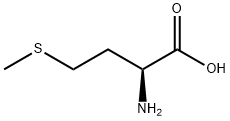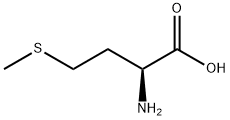L-Methionine
- CAS No.
- 63-68-3
- Chemical Name:
- L-Methionine
- Synonyms
- METHIONINE;MET;H-MET-OH;L-MET;L-Met-OH;l-methionin;H-L-MET-OH;lactet;Met-bNA;Acimethin
- CBNumber:
- CB9208759
- Molecular Formula:
- C5H11NO2S
Lewis structure
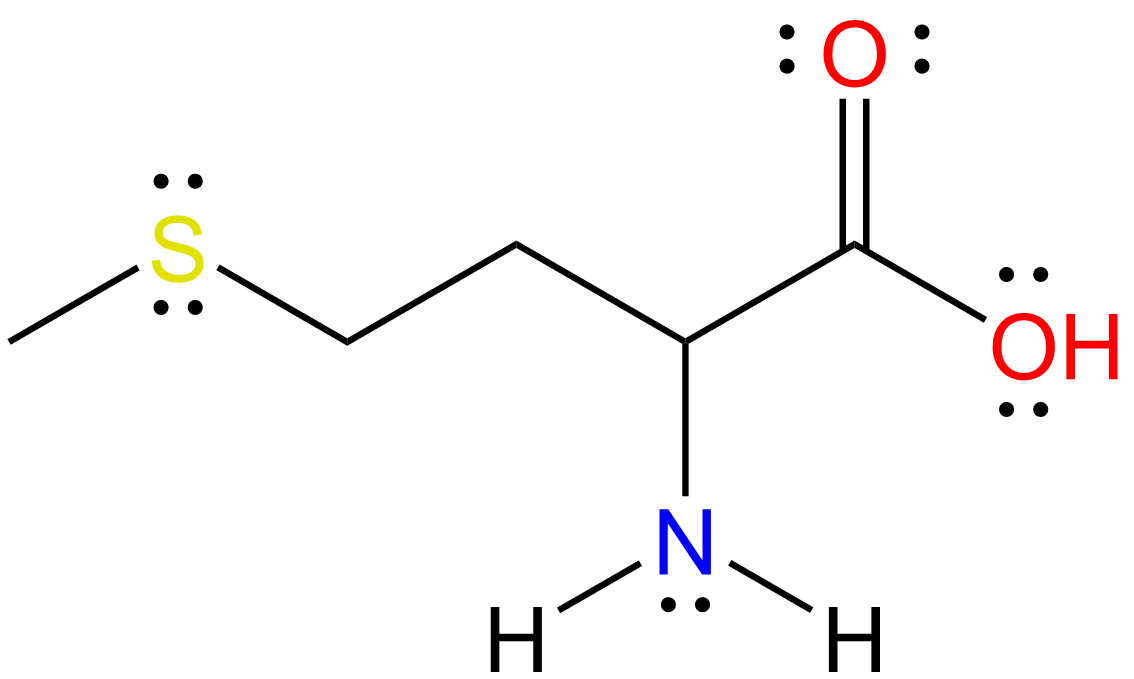
- Molecular Weight:
- 149.21
- MDL Number:
- MFCD00063097
- MOL File:
- 63-68-3.mol
- MSDS File:
- SDS
| Melting point | 284 °C (dec.)(lit.) |
|---|---|
| alpha | 23.25 º (c=2, 6N HCl) |
| Boiling point | 393.91°C (estimate) |
| Density | 1,34g/cm |
| refractive index | 1.5216 (estimate) |
| storage temp. | 20-25°C |
| solubility | 1 M HCl: 0.5 M at 20 °C, clear, colorless |
| form | Solid |
| pka | 2.13(at 25℃) |
| color | White |
| PH | 5-7 (10g/l, H2O, 20℃) |
| Odor | Slight characteristic |
| optical activity | [α]20/D +23.7±0.5°, c = 5% in 5 M HCl |
| Water Solubility | Soluble |
| λmax |
λ: 260 nm Amax: 0.40 λ: 280 nm Amax: 0.05 |
| Merck | 14,5975 |
| BRN | 1722294 |
| Stability | Stable. Incompatible with strong oxidizing agents. |
| LogP | 0.217 (est) |
| Substances Added to Food (formerly EAFUS) | L-METHIONINE |
| FDA 21 CFR | 172.320; 310.545 |
| CAS DataBase Reference | 63-68-3(CAS DataBase Reference) |
| EWG's Food Scores | 1 |
| FDA UNII | AE28F7PNPL |
| ATC code | V03AB26 |
| NIST Chemistry Reference | L-Methionine(63-68-3) |
| EPA Substance Registry System | L-Methionine (63-68-3) |
L-Methionine price More Price(83)
| Manufacturer | Product number | Product description | CAS number | Packaging | Price | Updated | Buy |
|---|---|---|---|---|---|---|---|
| Sigma-Aldrich | PHL82585 | L-Methionine phyproof? Reference Substance | 63-68-3 | 100mg | $262 | 2024-03-01 | Buy |
| Sigma-Aldrich | 8.16010 | L-Methionine for synthesis | 63-68-3 | 25G | $50.2 | 2024-03-01 | Buy |
| Sigma-Aldrich | 8.16010 | L-Methionine for synthesis | 63-68-3 | 100g | $137 | 2024-03-01 | Buy |
| Sigma-Aldrich | 64319 | L-Methionine BioUltra, ≥99.5% (NT) | 63-68-3 | 25G | $94.8 | 2024-03-01 | Buy |
| Sigma-Aldrich | 64319 | L-Methionine BioUltra, ≥99.5% (NT) | 63-68-3 | 100G | $300 | 2024-03-01 | Buy |
L-Methionine Chemical Properties,Uses,Production
Description
L-methionine is a sulfur-containing essential L-amino acid that is important in many body functions. Methionine is a dietary indispensable amino acid required for normal growth and development of humans, other mammals, and avian species. In addition to being a substrate for protein synthesis, it is an intermediate in transmethylation reactions, serving as the major methyl group donor.It must be obtained from diet and food sources since it is unable to be biosynthesized in the body. The minimum daily requirement of L-methionine for an adult male is 13 milligrams per kilogram of body weight. This quantity is normally easy to obtain from a complete diet.
Methionine is accepted as the metabolic precursor for cysteine. Only the sulfur atom from methionine is transferred to cysteine; the carbon skeleton of cysteine is donated by serine. (PMID: 16702340).It helps the body produce SAMe (S-Adenosyl-L-methionine), which has been used to treat psychiatric illnesses, infertility, liver problems, premenstrual disorders, and musculoskeletal conditions. Studies on SAMe have shown that it is as effective as tricyclic antidepressants in alleviating depression.
Ongoing studies that show promise are also being conducted to determine how effective L-Methionine may be for treating HIV/AIDS, liver damage, Parkinson's disease, and urinary tract infections.
chemical properties
L-methionine’s scientific name is methylthiobutanenitrile acid and is one of the essential amino acids. It is white flaky crystal or crystalline powder with specific odor. Its relative molecular weight is 149.21. DL-methionine(racemic)m.p. 281℃(decomposition). Its relative density is 1.340. It is soluble in water, dilute acid and dilute alkali solution and slightly soluble in 95% ethanol, which is insoluble in ether. L-methionine (L-body) melting point 280~281℃(decomposition). It is soluble in hot water and alcohol, which is insoluble in ethanol, ethyl ether, petroleum ether, benzene and acetone. D-methionine (D-body) Melting point 273 ℃ (decomposition). It is soluble water, acid and alkal and very slightly soluble in alcohol, insoluble in ether. Usually right-handed amino acids in body are invalid in biochemistry. However, this is the exception of methionine. D-methionine and L-methionine both are effective accelerator. This is due to the D-methionine in vivo can be converted into L-methionine. Therefore, the synthesis of DL-methionine does not require an analysis of points and can be used for the direct application. L-Methionineis one of the essential amino acids in the animal body, which is one of the components of the protein. It can maintain the growth and development of the body and balance nitrogen. It cannot be synthesized in animals in vivo and must be supplied in the form of amino acids or proteins from in vitro. L-Methionineis an important feed additive (nutrition enhancer). On the medical side, L-Methionineis one of the major components of amino acid infusion and compound amino acid preparation. It is also used for the prevention and treatment of liver disease and arsenic, benzene poisoning. It is also used as protein nutritional supplements for patients with protein deficiency or inadequate absorption. It can be obtained through the following steps: by the addition of methyl mercaptan and acrolein and then reacted with sodium cyanide and ammonium chloride .This step generates α-aminonitrile and then via hydrolysis to get the target production. It can also be obtained by hydrolysis of casein and then refined.
Feed additives
L-Methionine is mainly used as feed nutritional supplements and one of the essential amino acids in the growth of animals, which is the "skeleton" amino acid in protein biosynthesis and main donor of methyl in animal body. L-Methionineplays a certain role in the process of synthesis of choline by adrenal hormone and fatty liver phospholipids during the process of metabolism of the animal in vivo. Lacking of L-Methioninein livestock and poultry will lead to poor development, weight loss, liver and kidney function decline, muscle atrophy, fur deterioration, etc.
L-Methionine is a sulfur amino acid and the second limiting essential amino acids for pigs. The utilization ratio of feed protein can be improved effectively if lysine and L-Methioninewere added in the feed appropriately. So the lysine and L-Methionineare called enhancer for protein feed. Naturally occurring L-Methioninehas two types: D type and L type two and their biological utilization rate is identical. Synthetic L-Methionineis a type DL compound of type D and type L. The biological potency of compound is the same as that of the single D or L-methionine. The appearance of DL methionine additive is white to pale yellow crystal or crystalline powder and insoluble in water and has slightly sweetness haste. The content of L-Methioninein feed of pig is generally from 0.05% to 0.1%.
L-Methionineas a nutritional supplement, the effect of the type L is the same as that of the type of DL (due to the type L transformed from the type DL). Feed additives; as the product and cysteine both belong to sulfur-containing amino acids, so a large amount of them exist in animal proteins. However, it belongs to limiting amino acids in plant proteins such as oats, rye, rice, corn, wheat, peanuts, soybeans, potatoes, spinach and other vegetable foods and the content is less than animal proteins.So it can be added to the above food to improve the balance of amino acids. In the past, sulphur-containing amino acids were thought to be only suitable for non-ruminants. But now the experiment has been proved that it is applicable to the non-ruminants. It is more suitable for chicken and pig feed. On the medical side, it can be used for infusion together with other amino acids. Also used as a culture medium during fermentation.
Pharmacodynamics
L-Methionineis a sulfur-containing amino acid. Choline is synthesized in vivo by the L-Methioninesupplying the required methyl. And choline is a component of lecithin. Lecithin is an essential material for the removal of fat from the liver and the deposition of fat in the liver. So L-Methioninealso has an effect in choline lipotropic. In addition, L-Methioninein vivo supplies sulfur to synthesize non-exogenous amino acid Cys. The latter has the function of detoxification. Therefore, this medicine is used for the liver lipotropic in clinical , which is Suitable for fatty liver and chronic hepatitis and liver cirrhosis with fat infiltration. Clinical L-Methioninecan also be used as an adjuvant therapy drug for alcohol and poisoning.
Amino acids
Amino acids are the constituent units of the protein and are the material basis of life. From as large as human beings to as small as microorganism, they are both made up of proteins. Proteins are composed of peptides and peptide chains of peptides are composed of amino acids. Different proteins are made of peptide chains which are composed of amino acids in a different order and length. Genetically related genes are actually different sequences of amino acid chains. At present, there are total 28 kinds of amino acids related to the human body. These 28 amino acids are arranged in a different order and different length of the chain to compose the various parts proteins of the body. Of these 28 kinds of amino acids, nine species (about 32%) are required by the direct supply of dietary protein amino acids. They cannot be synthesized by other amino acids in the proteins that are taken in by the human body. They are leucine, isoleucine, valine, lysine, methionine, tryptophan, threonine, phenylalanine and histidine.
L-Methionineis an essential amino acid. It can help break down fat. So it can prevent fatty liver, heart disease, cerebrovascular disease and renal disease. The synthesis of amino acids, such as cysteine and taurine, requires the assistance of methionine.
This amino acid can help to remove harmful substances, such as lead and other heavy metals. It can prevent muscle weakness and brittle hair. It is also good for the prevention and treatment of osteoporosis or chemical allergies. It is good for the treatment of rheumatic fever and pregnancy toxemia.
L-Methionineis still a potent antioxidant. The sulfur L-Methioninewhich contains can eliminate free radicals. The synthesis of nucleic acids, collagen and protein in the body all require methionine. It is also good to take L-Methioninefor women taking contraceptives. Because the level of histamine in the blood of patients with schizophrenia is much higher than that of normal people, it can reduce the level of histamine in the body. Therefore, it is effective for the treatment of schizophrenia. If the body's toxic substances increase, the need for L-Methioninealso increases. As the body can change the L-Methionineinto cysteine, and cysteine is the precursor of glutathione; and glutathione is the main toxic liver neutralizers. So it will be able to protect the liver from harm toxic substances.
Methionine-rich foods: beans, other legumes, eggs, fish, garlic, meat, onions and yogurt.
Toxicity
LD50 36g/kg (rat, oral)
Safe for food (FDA§172.320,2000)
Uses
- Amino acid drugs, nutritional supplements. Used for fatty liver and cirrhosis. Also widely used as feed additives to improve feed quality, improve the utilization of the native protein and promote animal growth. Such as DL-methionine can increase egg production of chickens, pigs make weight gain, more milk cows and so on. Adverse reaction: hepatic coma hanged.
- Nutritional supplements. One of the essential amino acids of the human body. Because the price is higher than DL-methionine and the results are equal, so commonly used DL-methionine.
- For biochemical studies and nutritional supplements, and as adjunctive treatment for pneumonia, liver cirrhosis and fatty liver.
Description
Colorless or white lustrous plates, or a white crystalline powder. It has a slight, characteristic odor. It is soluble in water, in alkali solutions, and in dilute mineral acids. It is slightly soluble in alcohol and practically insoluble in ether.
Chemical Properties
Methionine occurs as a white or almost white, crystalline powder or colorless crystals.
Originator
Meonine ,Ives,US,1944
Uses
methionine is slows down and normalizes oil gland sebum production. Methionine is also used as a texturizer in cosmetic creams. It is an essential amino acid found in a number of proteins and obtained by means of fermentation.
Uses
L-Methionine is used as an essential amino acid for human development and therapeutically acts as an antidote for acetaminophen poisoning. It serves as a chelating agent for heavy metals, as a flavoring agent and nutritional supplement for foods. It acts as a feed additive, vegetable oil enrichment and as a single cell protein. In addition to this, it is used as a hepatoprotectant and also acts as a lipotropic agent and prevents excess fat buildup in the liver.
Uses
Essential aminoacid for human development. Hepatoprotectant; antidote (acetominophen poisoning); urinary acidifier.
Definition
ChEBI: L-methionine is the L-enantiomer of methionine. It has a role as a nutraceutical, a micronutrient, an antidote to paracetamol poisoning, a human metabolite and a mouse metabolite. It is an aspartate family amino acid, a proteinogenic amino acid, a methionine and a L-alpha-amino acid. It is a conjugate base of a L-methioninium. It is a conjugate acid of a L-methioninate. It is an enantiomer of a D-methionine. It is a tautomer of a L-methionine zwitterion.
Preparation
The production method of choice for L-methionine is still the enzymatic resolution of racemic N-acetyl-methionine using acylase from Aspergillus oryzae. The production is carried out in a continuously operated fixed-bed or enzyme membrane reactor.
Production Methods
Numerous methods have been described for manufacture of methionine, including hydrolysis of methionine amide )and 5-(bmethylmercaptoethyl)- hydantoin.
Manufacturing Process
A 3-necked flask fitted with a stirrer, thermometer, gas inlet, dropping funnel, and brine-cooled reflux condenser was charged with 53 g (1.1 mol) methyl mercaptan and 0.35 g mercuric methyl mercaptide. After admitting 56 g (1.0mol) of acrolein during the course of 15 minutes with an inside temperature of
about 10°C, the temperature was allowed to rise spontaneously to 75°C, at
which point an ice bath was applied. There was no indication of further
reaction one hour after the addition of the acrolein. Distillation of the product
gave 71 g (yield 68%) of β-methylmercaptopropionaldehyde, as described in
US Patent 2,584,496.
Then as described in US Patent 2,732,400, β-methylmercaptopropionaldehyde
(0.60 M) (56.5 g) is added to a stirred solution of sodium cyanide (0.66 M)
(32.4 g) and ammonium chloride (0.63 M) (33.7 g) in water (140 ml). The
temperature of the mixture rises to 49°C and is maintained at this point by
heat evolution for about 5 minutes when it slowly begins to fall. Methanol (50
ml) is added and the mixture is stirred for 4 hours as the temperature falls to
28°C (room temperature).
After chilling to +12°C, additional methanol (35 ml) and a concentrated
aqueous ammoniun hydroxide solution (1.4 M) (100 ml) are added and
stirring is continued for 2 hours at a temperature maintained at from +5° to
+15°C. The organic layer is separated and solvent is stripped from the
aqueous layer at water aspirator pressure at a temperature below 40°C. The
residue is extracted several times with chloroform and the chloroform extracts
are combined with the separated oil. Chloroform is removed at water aspirator
pressure at a temperature below 35°C to leave crude α-amino-γmethylmercaptobutyronitrile (methionine nitrile) in 88% yield (68 g) as a
clear, somewhat viscous oil.
The methionine nitrile (20 g) is dissolved in a solution prepared from 50 ml of
aqueous 5 N sodium hydroxide solution and 65 ml of ethanol. The solution is
then refluxed for 24 hours; ammonia is evolved. The solution is treated with
activated carbon, filtered, acidified with glacial acetic acid (17 ml), chilled to -
10°C and filtered to give crude product. This crude product is then slurried
with a solution made up of 20 ml of water and 20 ml of methanol, filtered at -
5° to +10°C and dried to give dl-methionine as white platelets.
Therapeutic Function
Lipotropic
Synthesis Reference(s)
Canadian Journal of Chemistry, 47, p. 3271, 1969 DOI: 10.1139/v69-542
Synthetic Communications, 26, p. 3619, 1996 DOI: 10.1080/00397919608003774
General Description
Minute hexagonal plates from dilute alcohol.
Air & Water Reactions
Reacts with water, steam, and/or acids to produce toxic and flammable vapors of hydrogen sulfide . Water soluble . pH of 1% aqueous solution is 5.6-6.0.
Reactivity Profile
An organosulfide and amine derivative, carboxylic acid. Look at Reactive Groups 20 (organosulfides), 7 (amines), and 3 (carboxylic acids) may give indications about reactive tendencies. L-Methionine is an amino acid essential in human nutrition.
Health Hazard
ACUTE/CHRONIC HAZARDS: L-Methionine is dangerous when heated to decomposition; it emits dangerous and highly toxic fumes.
Fire Hazard
Flash point data for L-Methionine is not available, but L-Methionine is probably combustible.
Pharmaceutical Applications
Methionine is used in oral pharmaceutical formulations as a flavoring agent.It has been included in parenteral formulations as a pH controlling agent,and it has also been used experimentally as an antioxidant with antibodies.Methionine is also used therapeutically in oral tablets
Biochem/physiol Actions
L-Methionine serves as precursor for transmethylation and transsulphuration. Methionine adenosylation results in the formation of S-adenosyl-L-methionine (SAM). SAM serves as a methyl donor to a number of substances. This methylation is significantly associated with the immune system functioning. Thus, SAM deficiency causes severe combined immunodeficiencies. L-Methionine′s metabolic product, glutathione, is known to regulate immune response and has antiviral action.
Safety Profile
Mildly toxic by ingestion and intraperitoneal routes. Human mutation data reported. An experimental teratogen. Experimental reproductive effects. An essential sulfur-containing amino acid. When heated to decomposition it emits very toxic fumes of NOx and SOx.
Safety
Methionine is used in oral pharmaceutical formulations. The pure
form of methionine is mildly toxic by ingestion and by the IP route.
LD50 (rat, IP): 4.328 g/k
LD50 (rat, oral): 36 g/kg
storage
Methionine is sensitive to light and should be stored in a cool, dark place.
Purification Methods
Crystallise L-methionine from aqueous EtOH. Also purify it by dissolving ~0.5g of amino acid in ~10mL of hot H2O, filtering, adjusting the pH to 5.8 with 5N HCl, collecting the solid after addition of ~20mL of EtOH. It is recrystallised by dissolving in H2O and adding EtOH. It sublimes at 197-208o/0.3mm with 99.8% recovery and unracemised [Gross & Gradsky J Am Chem Soc 77 1678 1955]. [Milne & Peng J Am Chem Soc 79 647 1957, Greenstein & Winitz The Chemistry of the Amino Acids J. Wiley, Vol 3 pp 2125-2152 1961, Beilstein 4 IV 3189.]
Incompatibilities
Methionine is incompatible with strong oxidizing agents.
Regulatory Status
Included in the FDA Inactive Ingredients Database (oral tablets). Included in parenteral preparations (injection solutions; powders for reconstitution) licensed in the UK.
L-Methionine Preparation Products And Raw materials
Raw materials
1of4
Preparation Products
1of2
| Supplier | Tel | Country | ProdList | Advantage | |
|---|---|---|---|---|---|
| DONBOO AMINO ACID COMPANY | +8613063595538 | donboo@donboo.com | China | 9363 | 58 |
| Hebei Weibang Biotechnology Co., Ltd | +8615531157085 | abby@weibangbio.com | China | 8812 | 58 |
| Hebei Mojin Biotechnology Co., Ltd | +86 13288715578 +8613288715578 | sales@hbmojin.com | China | 12840 | 58 |
| Hebei Chuanghai Biotechnology Co,.LTD | +86-13131129325 | sales1@chuanghaibio.com | China | 5893 | 58 |
| Hebei Kingfiner Technology Development Co.Ltd | +86-15532196582 +86-15373005021 | lisa@kingfinertech.com | China | 3010 | 58 |
| airuikechemical co., ltd. | +undefined86-15315557071 | sales02@sdzhonghuimaterial.com | China | 983 | 58 |
| Shaanxi TNJONE Pharmaceutical Co., Ltd | +8618092446649 | sarah@tnjone.com | China | 1143 | 58 |
| Hebei Zhuanglai Chemical Trading Co.,Ltd | +8613343047651 | admin@zlchemi.com | China | 3002 | 58 |
| HEBEI SHENGSUAN CHEMICAL INDUSTRY CO.,LTD | +86-15350851019 +86-15383190639 | admin@86-ss.com | China | 1000 | 58 |
| Aurora Industry Co., Ltd. | +86-13591747876 +86-13591747876 | alex1_auco@126.com | China | 277 | 58 |
Related articles
- What are the benefits and side effects of L-methionine?
- L-methionine and D-methionine are two different forms of methionine that differ in spatial configuration.
- Nov 2,2024
- L-Methionine: Benefits, Dosage and Safety
- L-Methionine is an essential sulphur-containing amino acid that is critical for many cellular functions, including protein syn....
- Aug 26,2024
- Methionine, L-methionine, and d- methionine
- L-methionine is the L-enantiomer of the amino acid methionine. It is essential for tissue repair.
- Nov 24,2023
View Lastest Price from L-Methionine manufacturers
| Image | Update time | Product | Price | Min. Order | Purity | Supply Ability | Manufacturer | |
|---|---|---|---|---|---|---|---|---|
 |
2024-11-22 | L-Methionine
63-68-3
|
US $0.00-0.00 / Kg/Drum | 1KG | 98.5%-101.5% | 10 TONS | WUHAN FORTUNA CHEMICAL CO., LTD | |
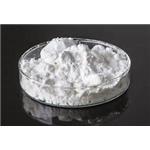 |
2024-11-22 | L-Methionine
63-68-3
|
US $100.00-75.00 / kg | 1kg | 99% | 5000 | HEBEI SHENGSUAN CHEMICAL INDUSTRY CO.,LTD | |
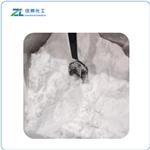 |
2024-11-22 | L-Methionine
63-68-0
|
US $99.00-35.00 / kg | 1kg | 99% | 5000 ton | Hebei Zhuanglai Chemical Trading Co.,Ltd |
-

- L-Methionine
63-68-3
- US $0.00-0.00 / Kg/Drum
- 98.5%-101.5%
- WUHAN FORTUNA CHEMICAL CO., LTD
-

- L-Methionine
63-68-3
- US $100.00-75.00 / kg
- 99%
- HEBEI SHENGSUAN CHEMICAL INDUSTRY CO.,LTD
-

- L-Methionine
63-68-0
- US $99.00-35.00 / kg
- 99%
- Hebei Zhuanglai Chemical Trading Co.,Ltd





